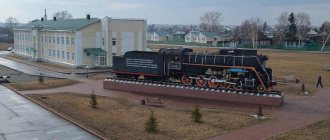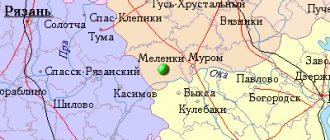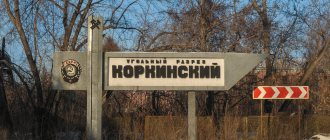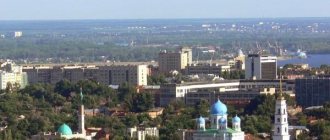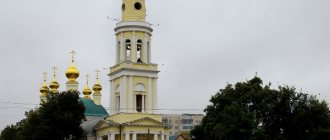- Reports and messages
- Miscellaneous
- City of Saransk
The city of Saransk is the capital of the Republic of Mordovia, which is part of the Volga Federal District.
1641 is considered the year of the founding of the city, which at that time was a fortress. The city has gone through stages of its development from a defensive fortress, a provincial district to a modern cultural and industrial center. Saransk is located 642 kilometers from Moscow. It is divided into two parts by the Insar River. The population of the city at the beginning of 2022 was about 320 thousand people, most of whom are Russians.
Saransk consists of three administrative districts: Leninsky, Proletarsky and Oktyabrsky. The Leninsky district is central and more cultural. It is in this area that there are a large number of schools, kindergartens, medical institutions, cinemas and theaters, stadiums and libraries. In the Leninsky district there are about twenty-five industrial productions and enterprises that provide jobs for the majority of residents. The production of electrical engineering and lighting engineering is the most important in Saransk. Mechanical engineering and the chemical industry are also well developed here. Saransk is now a city with modern and impressive buildings. A large number of them have appeared since the decision was made to host the 2022 World Cup football matches in the city.
The transport network of Saransk consists of trolleybuses, buses and minibuses. Among the attractions in the city of Saransk, one can highlight Cathedral Square, in the center of which is the huge luxurious Cathedral of Admiral F. Ushakov. There are no historical monuments in this city. But there are many different sculptures by the world-famous sculptor Stepan Erzya, who was born in Saransk.
Any tourist from young to old, visiting the city of Saransk, will be left with good impressions of this ancient city.
Option No. 2
What is the city of Saransk famous for? What is his history of command and prosperity? The city of Saransk is the capital of Mordovia, and Saransk is also an administrative city. This city is thriving every day! The industry in the city is very well developed, it is in high demand and popularity. Saransk is a cultural center, famous for its history and, of course, culture. The city can also boast of its economic component, as well as the achievement of great results in scientific terms. The city in its plan is very high quality and beautifully executed. Beautiful landscape design, nature and cleanliness of the city. All these components give an overall picture of a wonderful city. The city is very cozy, they say that any visitor can quickly get used to it and find their cozy nest. I can't help but note the cleanliness of the city. I have been to different cities, but apparently in Saransk people are more cultured, and the cleaners are more hardworking. Russian culture in the city of Saransk is combined with other traditional cultures.
The city was founded in one thousand sixty forty-one. And even then, at first it was very difficult to call it a city, because it was only a fortress that served for the defensive actions of the military in those years. Previously, this place was called “Saransky Ostrozhek”. Saransk, or, as they said in those years, “Sara,” is translated as a swamp, or wetland. This is how the name of the city of Saransk was born! The population of the fortress consisted of such people as: Cossacks, archers and other representatives of military affairs. But there were many inhabitants, or rather their nations, from Russians to Mokshas. This structure had a shape that resembled a square. And as you know, large towers were always placed in the corners in order to have a very broad outlook.
The structure was unique in that they not only had four towers on the edges, but they also decided to make two towers in the middle on one side and the other, and they also decided to place one of the largest towers in the center of their, so to speak, defensive base. Life and war reigned inside the building. There were all the conditions created for the life of the residents, food, clothing, and so on. There were also items for military operations or defense. Officially, the city of Saransk became a city only in one thousand seven hundred and eighty. But, oddly enough, it was already called a city eight years after the founding of this fortress.
History of the city of Saransk - briefly
Location of the city of Saransk in 642
kilometers east of Moscow at the intersection of important transport links between Astrakhan and Moscow and Kazan with Crimea make the capital of Mordovia an important economic center of the region.
Founding of Saransk
Saransk is named after the Saranka River. The word "sar", "sara", in ancient Mordovian means "branching". The founding of the city dates back to 1641
year, then the military fortress of Saransk fortress arose, which became part of the defensive structures in the southeast of the country.
The population of the young city was predominantly gunners, archers and Cossacks. The fortress was built from wood, had four towers and was fortified with earthen ramparts and ditches. A large settlement arose around the military structure, and by 1651
Saransk was already a district town. Residents were mainly engaged in crafts and trade.
Development of Saransk
IN 1670
In 1969, Saransk was captured by the troops of Stepan Razin, and it became one of the major centers of the peasant uprising. The peasants of Saransk supported the detachment with money, weapons, food, and some took part in the armed uprising.
K XVIII
century the city became an important commercial and industrial center of the Russian Empire. It has 5,500 inhabitants. Trade in grain crops, meat, leather goods, and honey is thriving, and small enterprises producing oil and leather are also developing.
Saransk was part of various provinces of the Russian Empire. WITH 1708
Saransk belonged to the Azov, and later to the Kazan and Simbirsk provinces.
IN 1774
year, the army of Emelyan Pugachev captured Saransk. The townspeople helped the rebels with food, and Pugachev was mistaken for Emperor Peter III, thereby giving him power over the city. Emelyan Pugachev released ordinary people from prisons and put officials, nobles, and church ministers in them. Many of them were executed.
IN 1785
year, by decree of Catherine II, the development of the city changed.
A strict rectangular street network appears in Saransk, churches and stone buildings are built. But urban development remains predominantly wooden. Large fires repeatedly destroyed the city's wooden dwellings, but Saransk was rebuilt. Despite losses from fires, until the 20th
century, wooden architecture predominated in the city.
WITH 1801
years, as part of the Penza province, the industrial development of the city and its redevelopment are noted.
Brick factories, soap factories, shag factories, and iron factories begin to operate in Saransk. In 1893
, Saransk became a city through which the railway ran from Moscow to Kazan.
In the 19th
century, Saransk managed to become the second largest city in the Penza province.
15
thousand people
lived here 37
factories operated. Industrial development was especially vigorous after the abolition of serfdom.
Saransk after the revolution
Soviet power came to Saransk in 1917
year. During the Civil War, the Don Cossack Cavalry Corps and the Twelfth Cavalry Division were formed in Saransk.
During World War II, uniforms, food, vehicles, and ammunition were manufactured in the city. Military units were formed, more than 8,000 soldiers did not return from the front. After the war, the city settled down: new residential areas appeared, industry developed, which allowed Saransk to become an industrial center.
Today Saransk is a multinational modern city. Russians, Erzyans and Mokshans, and Tatars live here. The engineering industry is well developed and tourism is developing.
Popular message topics
- Countries in Africa
They say that it was in Africa that people learned to walk on two legs and transformed into humans. The continent covers 4 types of climatic zones: equatorial, subequatorial, tropical and subtropical zones. Africa is washed by 2 oceans - Ancient India
Ancient India is a country that lived 2600-1900 BC. It was at this time that she reached her greatest dawn in development. India was located in Asia. It occupied a very large territory, - Ivan Kruzenshtern
One of the outstanding navigators of the late eighteenth - first third of the nineteenth century is deservedly considered Ivan Fedorovich Kruzenshtern. The future admiral was born in November 1770 into the family of a judge and was the seventh child in the family.
SARANSK
SARANSK, a city in Russia, the capital of the Republic of Mordovia, the center of the mountain of the same name. districts. Us. 320.6 thousand people (2019). Located on the river. Insar, at the confluence of the river. Saranka. Railway station. Road junction. Airport.
Story
Built in 1638–41 as a fort on the Atemar (from the 1650s Saransk) fortified line (preserved rampart) at the intersection of the Crimean and Sur roads. Since 1651 city and county center. In 1653, control of the fortified line was transferred to the north. In the fall of 1670, during the Razin uprising of 1670–71, it was occupied by a detachment of rebels under command. M. Kharitonov and for some time became their stronghold. On Dec. 1670, after several assault attempts, it was taken by the government. troops. From the 17th century a fair was held annually. The district town of Azov (1708–11), Kazan (1711–80, from 1719 as part of its Penza province), Penza (1780–97, 1801–1928; until 1796 – Penza governorship) and Simbirsk (1797–1801) provinces. In 1774, during the Pugachev uprising of 1773–75, it was occupied by the rebels without a fight, on July 27 (August 7) the city was visited by E. I. Pugachev, in August it was occupied by the government. troops. In the 19th century suffered from fires several times (1817, 1852, 1869). In 1893, traffic was opened on the railway that passed through the Northern Railway. line Sasovo - Sviyazhsk.
On Dec. 1917 Soviet power was established. Center of the Mordovian Okrug (1928–30), Mordovian Autonomous Okrug (1930–34), capital of the Mordovian Autonomous Soviet Socialist Republic (1934–90), Mordovian SSR (1990–94), Republic of Mordovia (since 1994). During the Great Patriotic War, several were based in S. military squadrons, the 326th Roslavl Rifle was formed. division. In 1958, the village was included within the northern boundaries. Posop (founded in 1638–42 as Inzersky fort).
Architecture
Church of the Three Saints. 1761–65. Photo by P. S. Pavlinov.
The center of the north retains the regular layout established by the general plan of 1785. On the left bank of the Saranka there are preserved: a 5-domed pillarless c. St. John the Evangelist (1693, bell tower - 1824), Trinity Church. (construction completed in 1771, refectory - 1893; since 1999, courtyard of the Sanaksar Monastery), buildings of public places (1816, project by A.D. Zakharov), commercial building. club (1916, now the city administration). On the right bank of the Saranka there is a Baroque church. Three Saints of the “octagon on quadrangle” type (1761–65), the so-called. Pugachevskaya tent (storeroom of the house of governor Kamenitsky, 1765); baroque-classical Nikolskaya c. (1800–1802; since 1992 Uspenskaya) and c. St. John the Baptist (1800–1803). On the right bank of the river. Insar – 5-headed c. St. Nicholas in Posop in the Russian style (1897–1906, architect A. E. Erenberg). In the beginning. 1930s over half of the churches were destroyed (including the Cathedral of the All-Merciful Savior, 1860–86). In the style of owls. Neoclassicism built the House of Soviets (1938–39, architect I.A. Meerzon), the House of Political Education (1953, now a music school), the House of Unions (1957, both - architect S.O. Levkov), State. rus. dramatic theater (1961, architect S. M. Gelfer), etc. In the 1960s–80s. Sovetskaya Square was built. with a monument to V.I. Lenin (1960, sculptor N.V. Tomsky) and the building of the regional committee of the CPSU (now the House of the Republic; 1986, architect G.G. Isakovich). According to the general plan of 1967, the Palace of Culture of Trade Unions (now the Republican; 1974, architect T. S. Kozyaev), Gor. cultural center (1976; rebuilt in 2011; now the State Musical Theatre), the Museum will depict. Arts (1976, architect V.I. Borisov and others), complex VDNKh Mord. ASSR (1979, architect V.G. Kargaev), etc. After 1990, the center was built. al-Mansur mosque (1995–2002), 5-domed church in honor of the Kazan Icon of the Mother of God (2001–11), Cathedral of St. Feodor Ushakov (2002–2006), cathedral mosque (2005–11), railway. station (2006–2009), center. Corps Mord. state University (2011–14). Monuments: to the crew of the Osoaviakhim-1 stratospheric balloon (1963, sculptor A. A. Pismenny, architect A. N. Dushkin), A. I. Polezhaev (1967, sculptor M. I. Kozhina), A. S. Pushkin ( 1977, sculptor E. F. Belashova), “Forever with Russia” (1986, sculptor I. D. Brodsky), S. D. Erze (1996), F. F. Ushakov (2006, both sculptor N. M. Filatov). Memorial complex to the soldiers of Mordovia who fell during the Great Ages. Otech. war (1970, Tomsky, Dushkin; Chapel of St. Alexander Nevsky, 2000), etc.
Centers of science and culture
State Musical Theater named after I.M. Yaushev. New building.
Among scientific institutions – Vseros. Scientific research institute technical physics and automation of the Federal Atomic Energy Agency, Mord. Research Institute s. wow, Mord. scientific and technical center information. Universities: Mord. state University named after N.P. Ogareva (founded in 1931, current status since 1957), Mord. state pedagogical Institute named after M. E. Evsevieva (1962); branches of Russia universities Operating: Center. state archive of the Republic of Mordovia (1928; current name since 1941), Centralizov. library systems - for adults (21 branches) and for children (5 branches). The largest library is Nat. fuck them. A. S. Pushkin (1899). Museums: Mord. Republican United Local Lore named after. I. D. Voronina (1918, current name since 2005; 9 branches); Mord. Republican will portray. Arts named after S. D. Erzi (1958; opened in 1960, current name since 1995); Memorial Military and Labor Feat 1941–45 (1995), its branch is the Museum of the poet A. I. Polezhaev (2001); Mordovian people culture (1999), etc. Theaters: State. rus. dramatic (founded in 1932 as part of the Mordovian National Theatre, after numerous transformations since 1994, modern name), puppet theater (1938, stationary since 1979), Mordovian state. national dramatic (1989, after separation from the Russian troupe), State. musical (1992, created on the basis of the Musical Comedy Theater; since 1994 named after I.M. Yaushev; since 2011 in a new building). State Philharmonic Society (1943, worked with a break in 1963–79), its composition included the Chamber Orchestra (2000), the women's folk ensemble “Kelu” named after. G. I. Suraev-Koroleva (1963), Cossack song and dance ensemble “Razgulay” named after. S. Balabana (2003) and others. Self-sufficient. groups of republican status: Chamber Choir (1991), song and dance ensemble “Umarina” (1941), folk ensemble “Torama” (1990), Song Theater “Rosichi” (founded in 1995 as a folk song ensemble), big band “ Saransk" (2002). The following festivals are held annually: modern festival. dance “New Fox” (in 1998–2006 “Fox”, since 2012 modern name), International ethno-jazz festival “Weise-jazz” (“Jazz together”, since 2002), International festival of Russian drama theaters “Compatriots” (with 2006).
Sport
Large sports center. Football club "Mordovia" (founded in 1961; participant of the Premier League championships of the 2012/13 and 2014–16 seasons; since 2022 it has been performing under the name "Mordovia-MTsPUFPM") hosts opponents at the Start stadium (opened in 2004; 11.6 thousand places). Olympic Training Center of the Republic of Mordovia for Race Walking (1995). Sports complex "Mordovia" (2004). Ice Palace (2007, 3 thousand seats). Tennis center named after. Shamilya Tarpishcheva (2008) and other sports arenas. The World Race Walking Cup was held in 2012. Several events took place in 2022. matches of the World Cup, for the beginning of which the Mordovia Arena stadium (up to 44 thousand seats) was built.
Farm
Mechanical engineering is the most developed, ch. arr. production of electrical products. Leading enterprises: Research Institute of Light Sources named after. A. N. Lodygina (1958; one of the significant Russian scientific and technical centers in the field of development of light sources; includes its own production base for the production of over 500 types of lamps, including UV radiation sources for disinfecting premises, special light sources for medical equipment, the needs of the defense industry, etc.) and other residents of the innovation-production complex "Technopark-Mordovia" ["Leader-Compound" (cables with peroxide cross-linked insulation), "Electric Rectifier" (power semiconductor devices), and companies operating in the field of information technology, electronic instrument making, energy-saving technology, optoelectronics, etc.), Saransk Lighting Engineering (1956; LED, sodium, metal halide, mercury, halogen lamps for general and special purposes; street lamps, bactericidal irradiators), Saranskkabel (cable- conductor products), enterprises of the Optikenergo group of companies: Saranskkabel-Optika, Em-Cable and Sarmat (production of fiber-optic cable, including one built into a lightning protection cable, fireproof cables, aluminum-clad steel wire , spiral reinforcement for power lines and overhead communication lines, wire rod made of aluminum alloys). There are also factories: precision instruments (components for electronic equipment and computer equipment), instrument-making (instruments for monitoring and measuring technological processes, motion parameters, pressure and temperature control, etc.), dump trucks (dump trucks, trailers, municipal special equipment, hydraulic equipment) , "Machine Tool" (metalworking equipment), "Franz Kleine" (agricultural machinery).
Among the large enterprises of other industries are the metallurgical company Mordovvtorsyryo (production of aluminum alloys from recycled materials), the RM Rail VKM-Steel company (iron and steel railcar casting), the Rezinotekhnika plants (1960; hydraulic and industrial hoses, technical plates) and “Biochemist” (1952; pharmaceutical products, including blood substitutes, injectable antibiotics). Production of disinfection equipment and water distillers (“Medical equipment”), paint and varnish products (“Akracom”), containers for the needs of various industries (“Sigma-plus”), furniture (“Orimex”), sewing and knitwear (“Mordovian patterns”), construction materials, etc. There are food industry enterprises: the Saransk pasta plant, a dairy plant, a cannery (canned meat, dairy, and vegetables), the Lamzur factory (confectionery), and the Saransk distillery. Saranskaya CHPP-2 (340 MW).
City information
Saransk is the capital of the Republic of Mordovia within the Russian Federation. Located on both banks of the Insar River. The economy is represented by enterprises in the metalworking, mechanical engineering, chemical, and food industries. There are trading and service companies operating.
Important highways pass near the settlement: M5 “Ural”, P180, P178. There is a station on the Kuibyshev Railway. The international airport of the same name is located. There are vocational educational institutions, universities and their branches. The population is about 300 thousand people.
